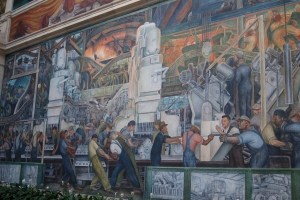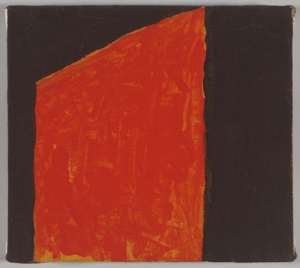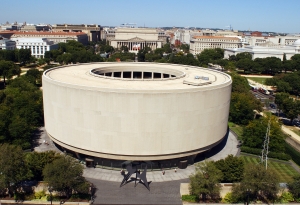|
Displaying items by tag: Museum
American Modern: Hopper to O’Keeffe will open at the Museum of Modern Art in New York on August 17, 2013. The exhibition will draw from MoMA’s extensive collection of American art made between 1915 and 1950. Using some of the finest paintings, drawings, prints, photographs and sculptures from the period, American Modern will illustrate the evolution of society and culture during the first half of the 20th century.
Subjects explored in the exhibition will include urban and rural landscapes, scenes of industry, still lifes and portraiture. Works by modern art masters such as George Bellows, Stuart Davis, Edward Hopper, Georgia O’Keeffe, Charles Sheeler, Alfred Stieglitz and Andrew Wyeth will be arranged thematically.
American Modern: Hopper to O’Keeffe will be on view at MoMA through January 26, 2014.

Thanks to a grant from Bank of America’s Art Conservation Project, the Detroit Institute of Arts has embarked on a research endeavor focused on examining and digitally photographing 13 full-scale preparatory drawings by Diego Rivera for his Detroit Industry murals. The drawings have not been viewed since 1986 and have never been photographed. The project, which started on July 22, 2013, will last through August 2, 2013 and will include any necessary conservation work on the drawings.
Rivera gave the drawings, which are housed in a climate-controlled custom storage in the museum, to the DIA after he completed his monumental Detroit Industry murals in 1933. The series of frescoes, which features 27 panels surrounding the museum’s Rivera Court, depict the then state-of-the-art Ford Motor Company River Rouge Plant. The murals stirred up controversy following their completion and critics deemed the works blasphemous, vulgar, un-American and Marxist propaganda. While members of the Detroit community called for the destruction of the murals, commissioner Edsel Ford and DIA Director Wilhelm Valentiner defended the murals’ right to exist.
Following the research project, 5 of the 13 panels will be go on view at DIA as part of an exhibition of works by Rivera and his wife Frida Kahlo created during their time in Detroit.

After three years at the helm of the Los Angeles Museum of Contemporary Art (MOCA), former New York art dealer, Jeffrey Deitch, is expected to resign as director. Deitch announced his intention to leave the institution to MOCA's trustees and board. He is currently in the middle of a five-year contract with the museum.
Prior to joining MOCA in 2010, Deitch ran the Deitch Project, a massively successful and pioneering contemporary art gallery in Manhattan. He also served on the authentication committee of the estate of Jean-Michel Basquiat, one of Deitch’s close friends.
Deitch’s tenure at MOCA has been plagued by criticism. After firing longtime chief curator Paul Schimmel in 2012, John Baldessari, Ed Ruscha, Catherine Opie and Barbara Kruger resigned from the museum’s board, leaving it void of artist representation. While MOCA was in poor financial standing when Deitch came on board, the museum continued to fall into financial despair during his time as director. The museum is just starting to regain its footing after fundraising efforts by board members garnered over $75 million in donations.
A meeting is schedule for MOCA’s board on Wednesday, July 24, 2013. A search committee is expected to form shortly after.

On July 27, 2013, the exhibition The Dorothy and Herbert Vogel Collection: Fifty Works for Fifty States will open at the Virginia Museum of Fine Arts. The show will present a portion of the couples incendiary collection, which they gifted to the museum in 2008. The works include examples of Minimal and Conceptual art as well as figurative and neo-expressionist pieces.
The late Herb Vogel, a postal clerk, and his librarian wife Dorothy, began collecting art in New York in 1962, the height of the minimal, conceptual and post-minimal movements. They eventually amassed over 4,000 works, primarily drawings, in a tiny Manhattan apartment on a shoestring budget. Five years ago, the Vogels partnered with the National Gallery of Art in Washington, D.C. and began a unique donation strategy. With the museum’s support, the couple distributed 2,500 works from their collection between every state in the country, with 50 works going to each one.
The Dorothy and Herbert Vogel Collection: Fifty Works for Fifty States will be on view at the Virginia Museum of Fine Arts through October 20, 2013.

Six Romanians will stand trial over the heist that took place at Rotterdam’s Kunsthal Museum this past October. Seven major paintings by artists such as Pablo Picasso, Claude Monet, and Henri Matisse were stolen during the robbery – the largest in years for the Netherlands.
The lifted works include Picasso’s Tete d’Arlequin, Matisse’s La Liseuse en Blanc et Jaune and Monet’s Waterloo Bridge, London and Charing Cross Bridge, London, which were on loan from the Triton Collection and on view as part of an exhibition celebrating the museum’s 20th anniversary. The paintings, which have not been recovered, are valued at more than $130 million. In May, investigators were analyzing ashes found in the home of one of the suspect’s mothers, raising fears that the works may have been incinerated.
Radu Dogaru and Adrian Procop are accused of masterminding the theft. Dogaru and several other suspects have been in custody since January 2013, while Procop remains at large. A date for the trial has not been set.

Boston-based collector, Dorothy Braude Edinburg, has gifted nearly 1,000 works of art to the Art Institute of Chicago, making it one of the most significant donations in the museum’s history. The gift includes approximately 800 works on paper – primarily European prints and drawings from Old Mast to modern – and 150 works of Asian art. The donation will complement the considerable long-term loans and prior gifts made by Edinburg including works by Vincent van Gogh (1853-1890), Paul Gauguin (1848-1903), Pablo Picasso (1881-1973) and Henri Matisse (1869-1954).
The most recent gift, along with Edinburg’s previous donations, is part of the Harry B. and Bessie K. Braude Memorial Collection, which honors Edinburg’s parents. Highlights include nearly 50 extremely rare Japanese volumes, many of which are from the Edo period, a sorely unrepresented period in American museum collections; Chinese celadons from the 12th and 13th centuries; and prints and drawings by Edgar Degas (1834-1917), Claude Monet (1840-1926), Edvard Munch (1863-1944) and James McNeill Whistler (1834-1903), among many others.
Edinburg said, “I have never thought of my collection as a personal endeavor. I have always believed that it should ultimately enter a major museum and serve a broad public…I have seen the Art Institute as the eventual home for my entire collection for many years, and I am thrilled to taking another step forward with this gift in honor of my parents.”

In November 2012, two members of the Metropolitan Museum of Art in New York sued the institution for making the public think that the suggested admission fees are mandatory. The historically free institution suggests entry fees of $25 for adults and less for seniors and students.
Theodore Grunewald and Patricia Nicholson filed the suit in state court in Manhattan and said that the museum’s fee policy lacks transparency. They also argued that the museum fails to note that the fee is suggested on several of its websites and that it’s only in fine and barely legible print on signs near cash registers. A statute was put in place in 1893 declaring that the Met must remain free in order to continue receiving government funding. Grunewald and Nicholson commissioned a survey of visitors to the museum and found that 85% of patrons believed they had to pay to gain entry.
According to court papers filed by Gerald Lee Jones, who worked at the Met as a floor manager from 2007 until 2011, cashiers were paid in part based on how much they collected from admission fees. The statement, which was filed in late June 2013, also suggested that cashiers were instructed to never volunteer that patrons may pay less than the “recommended” fee.
Harold Holzer, the Met’s senior vice president for public affairs, said that Jones, “one of the many floor managers” had a “glib spin on his experience [at the museum].” Holzer also asserted that the Met tracks how much the cashiers collect because auditors require admission figures. “It has nothing to do with performance evaluation or salary,” said Holzer, adding “The Met will offer its response in due course.”
During the year ending in June 2012, the Met brought in $37.8 million in admissions, about 16% of the museum’s revenue.

Less than two months after Richard Koshalek, the director of the Hirshhorn Museum and Sculpture Park in Washington, D.C. resigned, Constance Caplan, the chair of the museum’s board, has followed suit. Caplan announced her resignation in a strongly worded letter on July 8, 2013; she is the third member to leave the board since early June. Caplan cited lack of transparency, trust, vision and good faith as her reasons for leaving. Koshelek listed similar reasons in his resignation letter.
Staff members have been losing faith in the Hirshhorn since it embarked on its doomed Seasonal Inflatable Structure project in 2009. The project was continually stalled due to rising construction costs and conflicting feelings about the structure’s purpose. It was ultimately abandoned after Koshalek’s resignation.
The original vision was to create a 150-foot-tall bubble that would connect the inside and outside of the Hirshhorn and create additional space for installations and performances. Designed by Diller Scofidio & Renfro, the bubble was expected to cost over $12.5 million to create and install. Previous fund-raising efforts brought in about $7.8 million. When it was first announced, the Bubble garnered national attention and was applauded for being highly innovated.
The Cleveland Museum of Art acquired a rare enamel-on-copper copy of Titian’s (1485-1576) iconic 16th century masterpiece Bacchus and Ariadne by the English enamel painter Henry Bone (1755-1834). The museum purchased the 19th century work at Christie’s London on July 4, 2013 for $478,346. Curator John Seydl made the winning bid over the telephone from a London hotel in an effort to disguise the museum’s interest from other bidders.
The enamel measures 16 inches by 18 inches, which is exceptionally large for the medium typically used to execute portrait miniatures. The work includes an ornate gilt-wood and gesso frame and serves as a prime example of Bone’s innovative and widely admired enamel technique.
After being shipping to Cleveland, the Titian copy is expected to hang in the museum’s early 19th century gallery, which features French and English art.

In November 2012, two members of the Metropolitan Museum of Art in New York sued the institution for deceiving the public by making patrons think that the suggested admission fees are mandatory. The historically free institution suggests entry fees of $25 for adults and less for seniors and students.
Theodore Grunewald and Patricia Nicholson files the suit in state court in Manhattan and said that the museum’s fee policy lacks transparency. They also argued that the museum fails to note that the fee is suggested on several of its websites and that it’s only in fine and barely legible print on signs near cash registers. A statute was put in place in 1893 declaring that the Met must remain free in order to continue receiving government funding. Grunewald and Nicholson commissioned a survey of visitors to the museum and found that 85% of patrons believed they had to pay to gain entry.
According to court papers filed by Gerald Lee Jones, who worked at the Met as a floor manager from 2007 until 2011, cashiers were trained to deceive visitors and they were paid in part based on how much they collected from admission fees. The statement, which was filed in late June 2013, also suggested that cashiers were instructed to never volunteer that patrons may pay less than the “recommended” fee.
During the year ending in June 2012, the Met brought in $37.8 million in admissions, about 16% of the museum’s revenue.
|
|
|
|
|